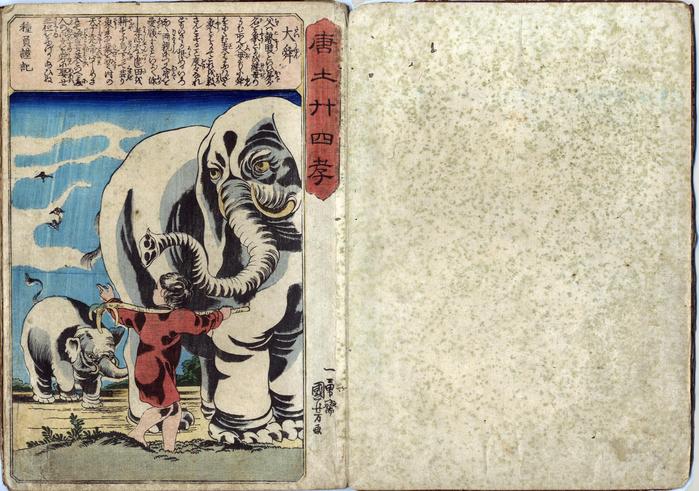Utagawa Kuniyoshi (歌川国芳) (artist 11/15/1797 – 03/05/1861)
Taishun (大舜) from the series The Twenty-four Chinese Paragons of Filial Piety (Morokoshi nijūshi-kō - 唐土廾四孝)
1847
13.5 in x 9.5 in (Overall dimensions) color woodblock print
Signed: Ichiyūsai Kuniyoshi ga
一勇斎国芳画
Harvard Art Museums
British Museum
Museum für angewandte Kunst, Vienna
Tokyo Metropolitan Library
Museum of Fine Arts, Boston
Hagi Uragami Museum of Art
Ritsumeikan University
Musées Royaux d'Art et d'Histoire (via Ritsumeikan University)
Art Institute of Chicago Below is R. Keller Kimbrough's translation of an early edition of the Nijūshikō. It does not specifically apply to this Kuniyoshi print except in the most general terms.
[1] Great Shun 大舜 (Da Shun)
Elephants in a row, tilling in the spring;“Great Shun was an exceedingly filial person. His father, whose name was Kosō 瞽叟—“Blind Old Man”—was remarkably stubborn, and his mother had a twisted heart. His younger brothers were extremely arrogant, and they were worthless, too. Nevertheless, Great Shun was fervent in his filial piety. One time when he was farming at a place called Mount Reki, Heaven was moved by his filial devotion.5 Great elephants came and tilled his fields, and birds flew to him and pulled the weeds, aiding him in his cultivation. At that time the ruler of the realm was named Emperor Gyō 堯王. He had two daughters, the elder of whom was called Gakō 娥皇, and the younger, Joei 女英. Having received word of Shun’s filial piety, Emperor Gyō immediately gave him his daughters to be his empresses, and in the end he left him the realm. This happened entirely as a result of Great Shun’s profound sense of filial piety.”
a flock of birds weeds the fields.
Succeeding Gyō, he rises to the jeweled throne;
his filial piety moves the emperor’s heart.
****
Laura Allen wrote on page 153 in The Printer's Eye: Ukiyo-e from the Grabhorn Collection in reference to an Okamura Masanobu of this same theme: "The series title Twenty-four Paragons of Filial Piety refers to a work said to have been composed by the Yuan dynasty (1279-1368) Chinese scholar Guo Jujing. The subject of this print is a virtuous young man known as Dashun (or simply Shun), who never deviated from proper respect toward his family despite harsh treatment from his father, his cruel stepmother, and her jealous son. When scolded or beaten, he simply escaped outside, cultivating the family fields alone. Noting his filial devotion, creatures emerged from the nearby mountains to help: in spring elephants came to plow the furrows, and in summer birds flocked to pull weeds. When the emperor heard this tale, he stepped in and guided the young man, until eventually Shun assumed the throne himself and became a virtuous ruler."
****
The book entitled The Twenty-four Paragons of Filial Piety was written by the Chinese scholar Guo Jujing during the Yuan Dynasty. His pen name was Yizi, and he is known in Japan as Kaku Kyokei. The book recounts the self-sacrificing behavior of twenty-four sons and daughters who go to extreme lengths to honor their parents, stepparents, grandparents, and in-laws. Many of the images in this series appear Western in style, rather than Japanese, and were probably copied from Italian prints. The prints in this edition appear to have been printed two per ōban sheet (about 9.5 x 13.5 inches) and folded to chûban pages (about 9.5 x 6.75 inches). The were once bound together in an album.
Chinese name: T’a Shun
Despite a neglectful father who favored his cruel stepmother and her son, Taishun cultivated land for his parents on Mount Li, where an elephant and a bird helped him with the difficult task. According to legend, Taishun eventually became emperor of China.
Robinson: S60.1
[The above information is all taken directly from the Kuniyoshi Project.]
The text reads: 大舜(たいしゆん) 父(ちゝ)は瞽?(こそう)といひ弟(おとゝ)が名(な)を象(しやう)とよび継母(けいぼ)のうむ所也父母(ふぼ)ともに舜(しゆん)をにくむ☆(こと)はなはだしく象(しやう)とはかりてこれを殺(ころ)さんとすること度々(どゞ)なれどもいさゝか恨(うら)めるいろなく両親(りようしん)につかへ弟(おとゝ)を愛顧(あいこ)することいよ/\深(ふか)し孝心(かうしん)天(てん)に通(つう)じ田(た)を耕(たがや)すに鳥(とり)下(くだ)って芸(くさぎ)り象(そう)来て業(わざ)を助(たす)く時の天子(てんし)尭帝(ぎやうてい)聞(きこ)しめされて娥皇(がくわう)女英(ぢよえい)といへる両人(ににん)の御女(おんむすめ)を舜(しゆん)に娶(めあは)せ王位(わうくらゐ)をゆづり給ひぬ 種員謹記
****
This image is illustrated in color in Ukiyoe Museums in Japan (Nihon no ukiyoe bijutsukan - 日本の浮世絵美術館), vol. 4, p. 122. This example is from the collection of the Chōfu Municipal Museum of Provincial History (調布市郷土博物館). They date their copy to 1853. This version has the artist's kiri seal in red below the signature.
****
The British Museum gives the title of this series as 'Todo nijushi-ko'.
Historical - Social - Ephemera (genre)
Fushimiya Zenroku (伏見屋善六) (publisher)
Nijūshikō (二十四孝: The twenty-four filial exemplars) (genre)
